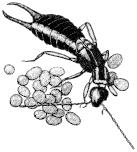
Earwigs are a relatively small group of insect that belong to the order Dermaptera. They are quite harmless to humans but can become an unwanted pest in the garden and occasionally in the home. Earwigs are mainly active at night, usually hiding during the daytime. They are often found in clusters in the soil, especially under wood, stone, mulch, compost and debris piles. They scavenge opportunistically on soil organisms, fungi, algae, eggs and immature stages of insects, such as fleas and aphids, as well as snails and other slow-moving invertebrates. Thus, they serve as beneficial predators of some other pests. Earwig damage is often minimal and tolerable, and often goes unnoticed unless the population becomes too high.
Damage
In the vegetable garden they may feed on seedlings, plant leaves, flowers, soft fruit and on corn silks, which can interfere with pollination. Immature earwigs tend to feed on seedlings and young leaves. Adult earwigs will feed on flowers and will climb into fruit trees, especially peaches, to feed on the ripening fruit. Younger plant leaves may have small holes all over the leaf and older leaves tend to be chewed around the edges. Leaves chewed by earwigs often have a ragged look.
Because earwigs forage at night, the best way to identify whether they are causing damage in the garden is to look for them with a flashlight at night. As populations increase and spread, the areas in which they hide become more unusual. For example, they may be found on a roof under shingles, under siding, or under items hanging on walls. Because earwigs also feed on decomposing organic matter, compost and mulch may provide food and shelter. Generally, they do not actively infest homes, but as they crawl up the foundation, any open area around the sill, doors or windows that will allow them to enter becomes an invitation to move in.
Control
Controlling earwigs can be done using two different approaches: baiting with food and baiting with shelter. Place a tuna fish can with the edges level with the ground, and fill it with about 1/2 inch of fish oil or bacon grease mixed with vegetable oil. Another type of trap involves creating shelters for the insects using rolled up dampened newspaper or cardboard or a one foot long hose placed in shady areas of the garden, or by placing boards on the ground. Once trapped, shake the earwigs into a bucket of soapy water. Pesticides labeled for earwig control can be used outdoors and should be spread as directed around the home. Typically, they are applied around the foundation, especially by basement doors and windows, where the sill of the house rests on the foundation, and where the siding starts. If baits are used it is often recommended to sprinkle just enough water over them to soften them and make the bait more attractive to earwigs. ALWAYS read and follow the directions. Cleanliness is important in preventing earwig populations from becoming too large. Avoid providing earwigs with ideal nesting and hiding places such as piles of leaves, dead perennial foliage, thick mulch layers, and weedy areas. Removing these hiding places is a continuous job but the most important time to discourage earwigs from establishing high populations is in the spring when plants have not yet sprouted and most outdoor debris can be removed.
Despite good cultural practices, pests and diseases at times may appear. Chemical control should be used only after all other methods have failed.
For pesticide information or other questions please call toll free: 877-486-6271.
Pesticide Safety Tips. READ THE LABEL on each pesticide container before each use. Apply as directed. Heed all warnings and precautions. Store pesticides in their original labeled containers out of reach of children, irresponsible people and pets, preferable under lock and key. Dispose of empty containers safely.
Revised by the UConn Home & Garden Education Center, 2016.